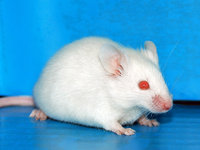Strain Data Sheet
RBRC01868
Strain Information | |
|---|---|
| Image |  |
| BRC No. | RBRC01868 |
| Type | Targeted Mutation |
| Species | Mus musculus |
| Strain name | FVB.Cg-Ptgds<tm1(cre)Gvn>/GvnRbrc |
| Former Common name | Pgds-Cre |
| H-2 Haplotype | |
| ES Cell line | |
| Background strain | |
| Appearance | |
| Strain development | Developed by Dr. Marco Giovannini, INSERM France. |
| Strain description | Pgd2-cre knock-in mouse. A cre recombinase gene was knocked into exon1 of Pgds. |
| Colony maintenance | |
| References | Identification of a progenitor cell of origin capable of generating diverse meningioma histological subtypes. Kalamarides M, Stemmer-Rachamimov A O, Niwa-Kawakita M, Chareyre F, Taranchon E, Han Z Y, Martinelli C, Lusis E A, Hegedus B, Gutmann D H, Giovannini M Oncogene, 30(20):2333-2344 (2011). 21242963 |
Health Report | |
|---|---|
| Examination Date / Room / Rack | |
Gene | |||||||
|---|---|---|---|---|---|---|---|
| Gene Symbol | Gene Name | Chr. | Allele Symbol | Allele Name | Common Names | Promoter | Diseases Related to This Gene |
| HBB2 | rabbit beta-globin polyA | 2 | HBB2 | ||||
| Ptgds MGI:1859384 | hematopoietic prostaglandin D synthase | 2 | Ptgds<tm1.1(cre)Gvn> MGI:5051626 | targeted mutation 1.1, (cre) Marco Giovannini | |||
| cre | Phage P1 Cre recombinase | 2 | cre | Pgds | |||
| loxP | phage P1 loxP | 2 | loxP | ||||
| Simian virus 40 Large T antigen nuclear localization signal (NLS) | 2 | ||||||
Phenotype | |
|---|---|
| Annotation by Mammalian phenotyhpe ontology | |
| Detailed phenotype data | |
Ordering Information | |
|---|---|
| Donor DNA | Simian virus 40 Large T antigen nuclear localization signal (NLS), Phage P1 cre recombinase, Rabbit beta-globin poly A, Phage P1 loxP site, mouse Pgds genomic DNA |
| Research application | Cre/loxP system Cre driver |
| Specific Term and Conditions | In publishing the research results to be obtained by use of the BIOLOGICAL RESOURCE, an acknowledgment to the DEPOSITOR is requested. RECIPIENT shall keep DEPOSITOR apprised of any results obtained from the BIOLOGICAL RESOURCE in the course of the research, as soon as they are available. Moreover, if the research results in a potential invention or a substance that may have potential commercial value (hereinafter referred as to the "Invention") RECIPIENT will promptly disclose this Invention to DEPOSITOR with samples thereof for DEPOSITOR's internal use. RECIPIENT and DEPOSITOR will consult together and agree about the possibility of filing one or more patent application to Invention conceived by one or more employees of Recipients that directly arise out of the research. The Parties will negotiate in good faith the conditions of such patent application according to each party's inventiveness contribution in the Invention. In case of such Invention, patentable or not, reduced in practice or developed in the course of the research that could not have been obtained, reduced to practice or developed but from using the Material and/or Confidential Information, RECIPIENT and DEPOSITOR shall confer with one another as regards licensing and commercialization of such Invention to negotiate in good faith the terms of an institutional agreement as regards said matters. |
| Depositor | Marco Giovannini (INSERM) |
| Strain Status |  Frozen embryos Frozen embryos Frozen sperm Frozen sperm |
| Strain Availability | Recovered litters from cryopreserved sperm (2 to 4 months) Cryopreserved sperm (within 1 month) |
| Additional Info. | Necessary documents for ordering:
Genotyping protocol -PCR- |
BRC mice in Publications |
|---|
Wang TA, Chen C, Huang F, Feng S, Tien J, Braz JM, Basbaum AI, Jan YN, Jan LY. TMEM16C is involved in thermoregulation and protects rodent pups from febrile seizures. Proc Natl Acad Sci U S A 118(20) (2021) 33972431 |
Wang TA, Teo CF, Åkerblom M, Chen C, Tynan-La Fontaine M, Greiner VJ, Diaz A, McManus MT, Jan YN, Jan LY. Thermoregulation via Temperature-Dependent PGD2 Production in Mouse Preoptic Area. Neuron 103(2) 309-322.e7(2019) 31151773 |